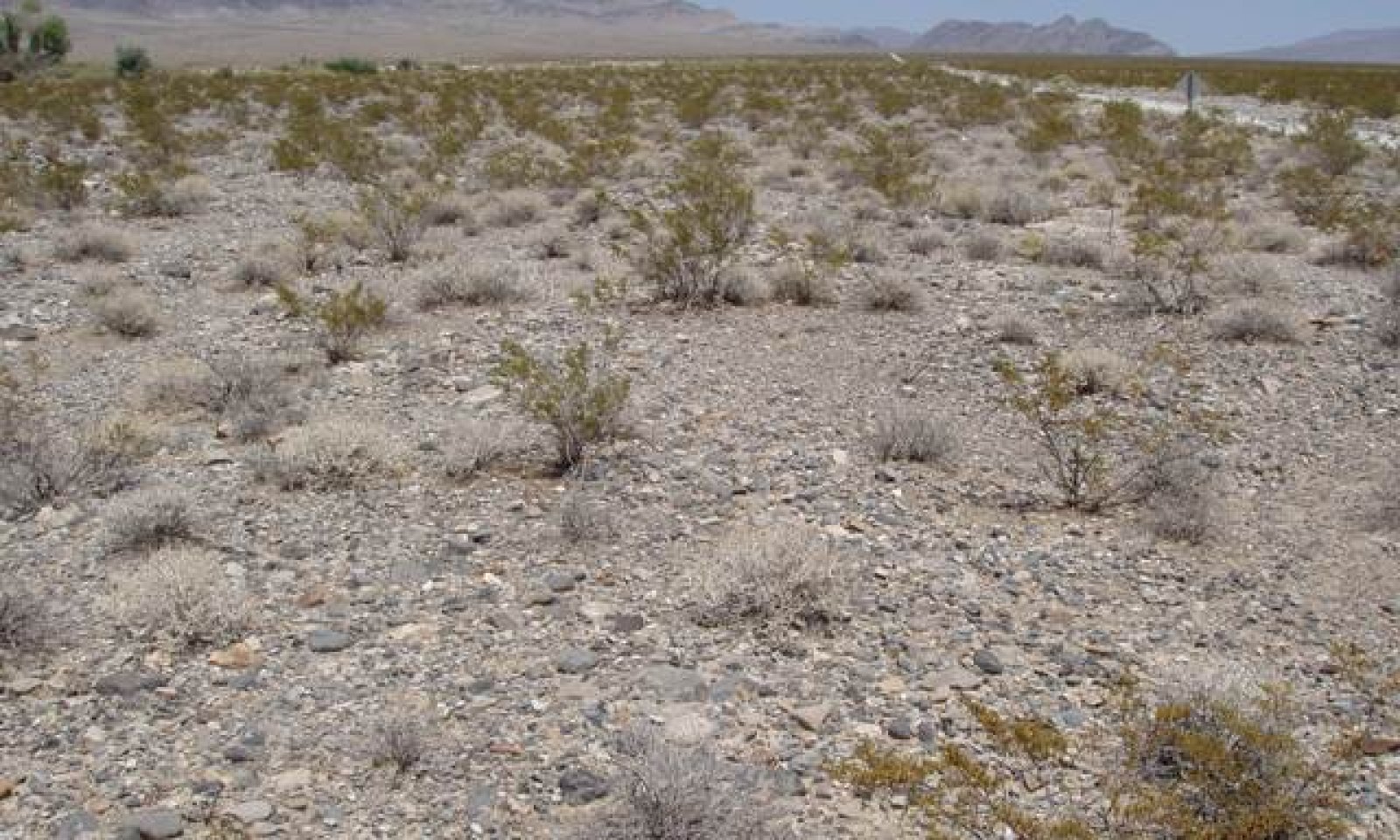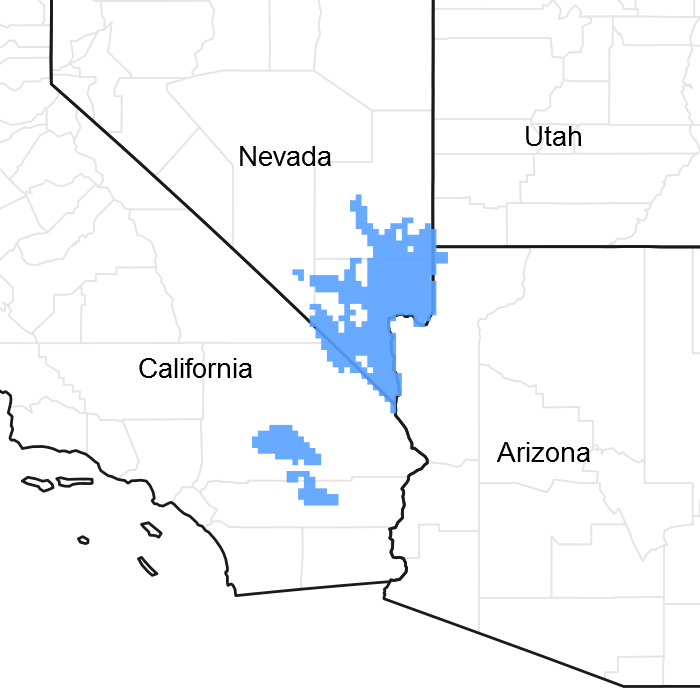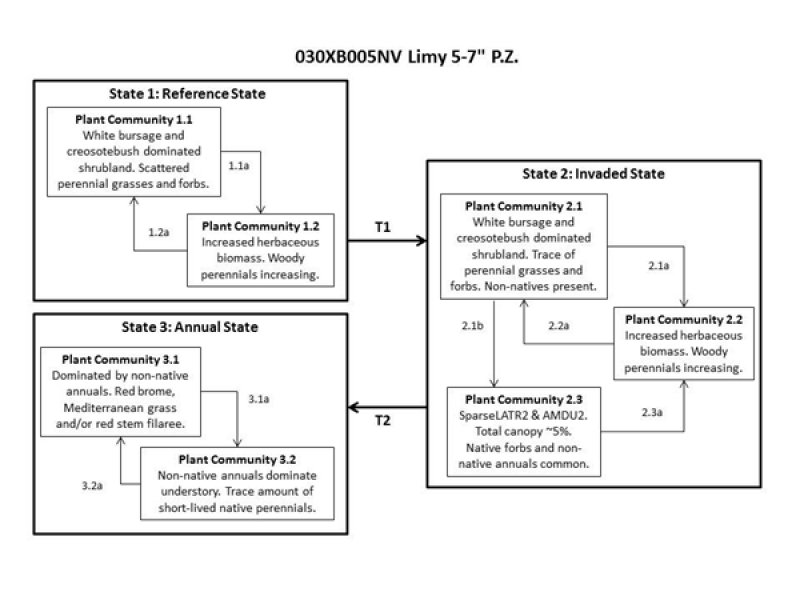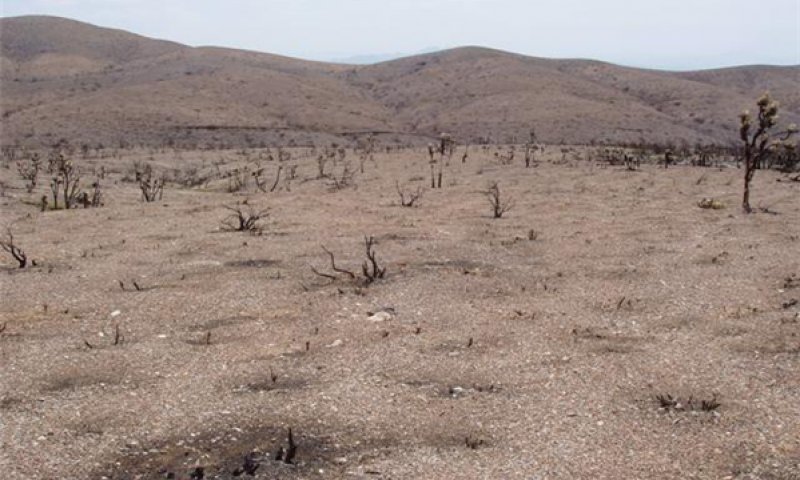

Natural Resources
Conservation Service
Ecological site R030XB005NV
Arid Active Alluvial Fans
Last updated: 3/11/2025
Accessed: 12/21/2025
General information
Provisional. A provisional ecological site description has undergone quality control and quality assurance review. It contains a working state and transition model and enough information to identify the ecological site.

Figure 1. Mapped extent
Areas shown in blue indicate the maximum mapped extent of this ecological site. Other ecological sites likely occur within the highlighted areas. It is also possible for this ecological site to occur outside of highlighted areas if detailed soil survey has not been completed or recently updated.
MLRA notes
Major Land Resource Area (MLRA): 030X–Mojave Basin and Range
MLRA Description:
Major Land Resource Area (MLRA) 30, Mojave Desert, is found in southern California, southern Nevada, the extreme southwest corner of Utah and northwestern Arizona within the Basin and Range Province of the Intermontane Plateaus. The climate of the area is hot and dry with mostly hyperthermic and thermic soil temperature regimes and typic-aridic soil moisture regimes. Mean annual air temperatures are between 59-68 degrees F (15-20 C) with average summer maximum temperatures between 100-115 degrees F (38-46 C) and average winter minimum temperatures between 32-59 degrees F (0-15 C). This MLRA is within the arid climate zone however steep elevational gradients contribute to microclimates where semi-arid [mean annual precipitation is greater than 8 inches (200mm)] and hyper-arid [mean annual precipitation is less than 4 inches (100mm)] islands exist. Elevations range from below sea level to over 12,000 feet (3650 meters) in the higher mountain areas. Generally above 5,000 feet, soil temperature regimes can be mesic, cryic and frigid with soil moisture regimes being xeric or ustic. Orographic effects and low elevations can create hyper-arid conditions where the soil moisture regime is aridic-aridic. Due to the extreme elevational range found within this MLRA, land resource units (LRUs) were designated to group areas within the MLRA into similar land units.
LRU Description:
The arid climate zone (XB in ESD ID) LRU is found across the eastern half of California, much of the mid-elevations of Nevada, the southernmost portions of western Utah, and the mid-elevations of northwestern Arizona. Elevations range from 1800-5000 feet and precipitation ranges from 4-8 inches/year. Precipitation is bi-modal for most of the Mojave with precipitation occurring in winter and summer. Areas west of the 117 degree W meridian near Barstow, CA receive precipitation mainly during the winter months (Hereford et al. 2004). The soil temperature regimes are hyperthermic and thermic with a typic-aridic soil moisture regime. Vegetation includes creosote bush (Larrea tridentata), burrobush (Ambrosia dumosa), Mojave yucca (Yucca schidigera) Joshua tree (Yucca brevifolia), chollas, cactus, big galleta grass (Pleuraphis rigida) and several other warm season grasses. At the upper portions of the LRU, where the mean annual precipitation is between 6 to 8 inches (150-200 mm), plant production and diversity are greater and blackbrush (Coleogyne ramosissima) is a common dominant shrub.
Classification relationships
U.S. National Vegetation Classification (USNVC): 3 Desert and Semi-Desert, 3.A Warm Semi-Desert Scrub and Grassland, 3.A.1 Warm Semi-Desert Scrub and Grassland, D039 North America Warm Desert Scrub and Grassland, M088 Mojave-Sonoran Semi-Desert Scrub, G295 Sonoran-Mojave Creosotebush- White Bursage Desert Scrub Group, CEGL000956 Ambrosia dumosa – Larrea tridentata var. tridentata Dwarf-shrubland.
Ecological site concept
This site is extensive in the Mojave Desert and typically occurs on fan piedmonts, broad alluvial fans and fan remnants on all exposures. Slopes range from 2 to 30 percent, but slope gradients of 2 to 15 percent are typical. Elevations are 1200 to 4800 feet.
The soils associated with this site are typically shallow to moderately deep. The soils typically have a calcic horizon shallow to the surface. Soil depth to a layer restrictive to root development, such as a petrocalcic horizon, is greater than ten inches. Limy soils found within this site generally have low organic matter, high alkalinity and a coarse texture. This white bursage-creosotebush plant community is extensive throughout the Mojave Desert and consists of both long and short-lived perennial species.
This is a group concept and provisional STM that also covers the following ecological sites: R030XA058NV, R030XA071NV, R030XA073NV, R030XB156CA, R030XF028CA, R030XY110UT.
Associated sites
| R030XB001NV |
LIMY HILL 5-7 P.Z. |
|---|---|
| R030XB004NV |
SANDY 5-7 P.Z. |
| R030XB019NV |
Eroded Fan Remnant Pavette 4-6 P.Z. |
| R030XB039NV |
LIMY FAN 5-7 P.Z. |
| R030XB079NV |
GYPSIC SLOPE 3-5 P.Z. |
Similar sites
| R030XY110UT |
Desert Loam (Creosotebush) Essentially the same ecological site concept as R030XB005NV. |
|---|---|
| R030XB039NV |
LIMY FAN 5-7 P.Z. More productive site; PLRI3 dominant plant |
| R030XB205AZ |
Sandy Loam Upland 6-10" p.z. Limy Subsurface, Gravelly Essentially the same ecological site concept as R030XB005NV. |
| R030XB075NV |
GRAVELLY FAN 5-7 P.Z. More productive site; PLRI3 dominant plant |
| R030XB004NV |
SANDY 5-7 P.Z. PLRI3-ACHY codominant grasses; sandy soils |
| R030XB019NV |
Eroded Fan Remnant Pavette 4-6 P.Z. Less productive site; LATR2 dominant shrub |
| R030XB074NV |
COBBLY LOAM 5-7 P.Z. MESP2 common shrub |
| R030XA121AZ |
Limy Fan 3-6" p.z. Sandy Essentially the same ecological site concept as R030XB005NV. |
| R030XB156CA |
Limy 5-7" p.z. (Low Production) Essentially the same ecological site concept as R030XB005NV. |
| R030XB211AZ |
Limy Fan 6-9" p.z. Essentially the same ecological site concept as R030XB005NV. |
| R030XA105AZ |
Limy Fan 3-6" p.z. Essentially the same ecological site concept as R030XB005NV. |
| R030XB017NV |
LIMY HILL 3-5 P.Z. Less productive site; occurs on steep slopes |
| R030XB102NV |
GRAVELLY LOAM 5-7 P.Z. KRLA2 major shrub |
| R030XB227AZ |
Clay Loam Upland 6-9" p.z. Essentially the same ecological site concept as R030XB005NV. |
| R030XB001NV |
LIMY HILL 5-7 P.Z. Less productive site; occurs on steep slopes |
| R030XA058NV |
LIMY 5-7 P.Z. Essentially the same ecological site concept as R030XB005NV. |
| R030XB206AZ |
Cobbly Limy Upland 6-9" p.z. Deep Essentially the same ecological site concept as R030XB005NV. |
| R030XB226AZ |
Sandy Loam Upland 6-9" p.z. Fine Essentially the same ecological site concept as R030XB005NV. |
Table 1. Dominant plant species
| Tree |
Not specified |
|---|---|
| Shrub |
(1) Ambrosia dumosa |
| Herbaceous |
(1) Pleuraphis rigida |
Click on box and path labels to scroll to the respective text.


